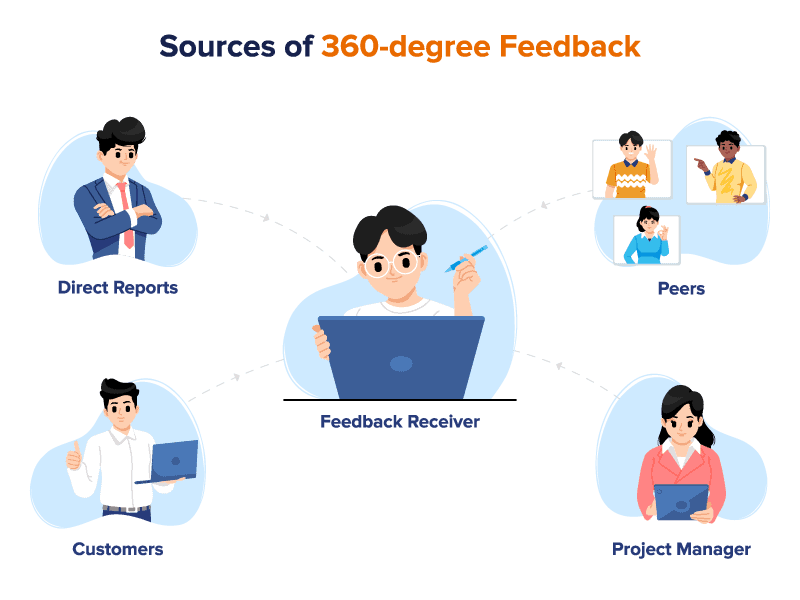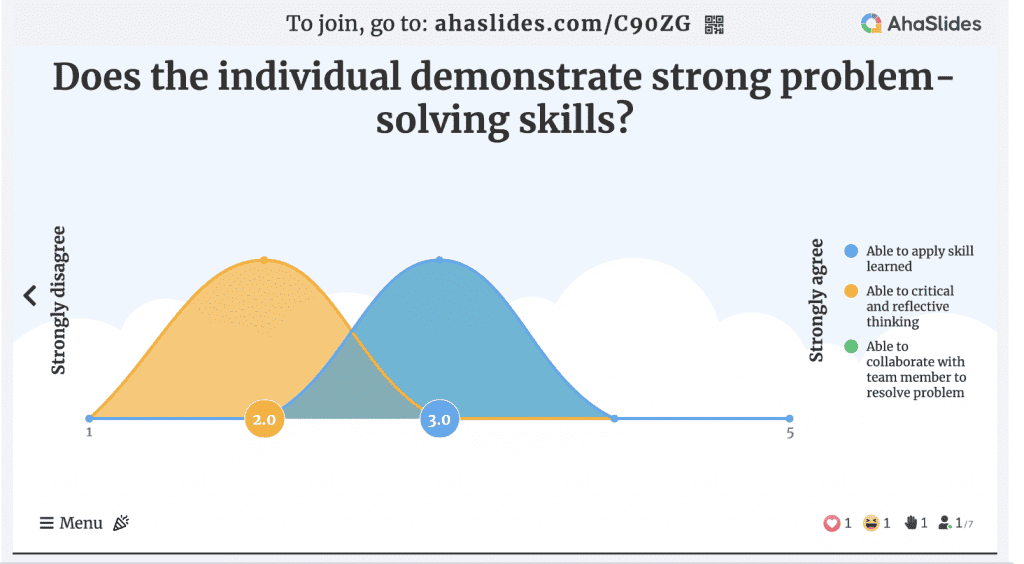Is 360 Degree Feedback effective? If you're looking for an effective way to measure your employee's performance, then 360-degree feedback is the way to go. Let's check out what is 360 Degree Feedback, its pros and cons, its examples, and tips to make sure your employee evaluation shows its effectiveness.

Better Ways for Engagement at Work
Table of Contents
- What is 360 Degree Feedback?
- Why is using 360 Degree Feeback important?
- Disadvantages of 360 Degree Feedback
- 360 Degree Feedback examples (30 Phrases)
- Tips to get 360 Degree Feedback right
- Design a powerful 360 Degree Feedback for your Company
- Bottom Line
What is 360 Degree Feedback?
360-degree feedback, also known as multi-rater feedback or multi-source feedback, is a type of performance appraisal system that involves gathering feedback from different sources, including peers, managers, subordinates, customers, and other stakeholders who interact with an employee on a regular basis.
The feedback is collected anonymously and covers a range of competencies and behaviours that are important for the employee's role and the organization's goals. The feedback can be collected through surveys, questionnaires, or interviews and is usually conducted periodically, such as annually or bi-annually.

Why is using 360 Degree Feeback important?
There are many reasons why using 360 Degree feedback is important.
Perceive strengths and weaknesses
It provides a more complete picture of your performance than traditional feedback methods, such as a performance review conducted by your boss. By receiving feedback from a wide range of sources, you can gain a better understanding of your strengths and weaknesses, and get a more accurate sense of how others perceive you.
Identify blind spots
In addition to providing a more comprehensive view of your performance, 360 Degree feedback can also help you identify blind spots that you may not have been aware of. For example, you may think that you are a great communicator, but if multiple people provide feedback suggesting that you need to work on your communication skills, then you may need to re-evaluate your perception of your own abilities.
Build strong relationship
Another benefit of using 360 Degree feedback is that it can help you build stronger relationships with your colleagues and other stakeholders. By soliciting feedback from others, you demonstrate that you are open to constructive criticism and interested in improving yourself. This can help build trust and respect and can lead to better collaboration and teamwork.

Looking for an engagement tool at work?
Use fun quiz on AhaSlides to enhance your work environment. Sign up to take free quiz from AhaSlides template library!
🚀 Grab Free Quiz☁️
5 Disadvantages of 360 Degree Feedback
If you are considering whether 360 Degree Feedback can be suitable for your company system, take a look at the below points.
Biases and Subjectivity
360-degree feedback is highly subjective and can be influenced by various biases, such as the halo effect, recency bias, and leniency bias. These biases can affect the accuracy and fairness of the feedback, resulting in incorrect evaluations and negative consequences for the employees.
Lack of Anonymity
360-degree feedback requires individuals to provide feedback about their colleagues, which can create a lack of anonymity. This can lead to reluctance among employees to provide honest feedback, as they may fear reprisals or damage to working relationships.
Time-Consuming
Gathering feedback from multiple sources, compiling the information, and analyzing it is a time-consuming process. This can result in delays in the feedback process, reducing its effectiveness.
Costly
Implementing a 360-degree feedback program can be costly, particularly if it involves hiring external consultants or purchasing specialized software to manage the process.
Implementation Challenges
Implementing a 360-degree feedback program requires careful planning, communication, and training. If not implemented correctly, the program may not achieve its objectives, resulting in wasted time and resources. Additionally, employees may not trust the process, leading to resistance and low participation rates.

360 Degree Feedback examples (30 Phases)
To make your feedback constructive and inspiring, choosing what kind of attribute to put on your evaluation is necessary, such as leadership skills, problem-solving, communication, collaboration, and more. Here is the list of 30 general questions that you can put on your survey.
- How effective is the individual in communicating with their colleagues?
- Does the individual demonstrate strong leadership skills?
- Is the individual receptive to feedback and open to constructive criticism?
- Does the individual effectively manage their workload and prioritize tasks?
- Does the individual exhibit a positive attitude and contribute to a positive work environment?
- How well does the individual collaborate with their team members and other departments?
- Does the individual demonstrate strong problem-solving skills?
- Does the individual demonstrate a commitment to professional growth and development?
- How well does the individual adapt to change and handle stress?
- Does the individual consistently meet or exceed performance expectations?
- How well does the individual handle conflict or difficult situations?
- Does the individual demonstrate effective decision-making skills?
- How well does the individual manage relationships with clients or customers?
- Does the individual provide constructive feedback to their colleagues?
- Does the individual demonstrate a strong work ethic and commitment to their role?
- Does the individual demonstrate effective time management skills?
- How well does the individual manage and delegate tasks to their team?
- Does the individual demonstrate effective coaching or mentoring skills?
- How well does the individual manage their own performance and track progress?
- Does the individual demonstrate effective listening skills?
- How well does the individual manage and resolve conflicts within their team?
- Does the individual demonstrate effective teamwork skills?
- How well does the individual prioritize their work in alignment with organizational goals?
- Does the individual have a strong understanding of their role and responsibilities?
- Does the individual take initiative and drive innovation within their team?
- How well does the individual adapt to new technologies or changes in the workplace?
- Does the individual demonstrate a strong commitment to customer satisfaction?
- Does the individual demonstrate effective networking or relationship-building skills?
- How well does the individual manage and motivate their team to achieve goals?
- Does the individual demonstrate ethical behaviour and conduct in the workplace?
Tips to get 360 Degree Feedback right
It is undeniable that 360-degree feedback is an effective tool for evaluating employee performance, but it's crucial to get it right. By following these dos and don'ts, you can ensure that the feedback process is productive and beneficial.
360 Degree Feedback - Dos:
1. Establish clear objectives: Before starting the feedback process, it's crucial to set clear goals and objectives. Ensure that everyone involved understands the purpose of the feedback and what is expected of them.
2. Choose the right raters: It's important to select raters who have professional relationships with the individual being evaluated. They should be familiar with the employee's work and have regular interactions with them.
3. Encourage honest feedback: Create an environment that encourages honest and constructive feedback. The raters should feel comfortable sharing their opinions without fear of retribution.
4. Provide training and support: To ensure that the raters provide useful feedback, they need to be trained on how to give feedback effectively. You may also need to provide support to the person receiving the feedback to help them understand and act on the feedback.
360 Degree Feedback - Don'ts:
1. Use it as a performance evaluation: Avoid using 360-degree feedback as a tool for performance evaluation. Instead, use it as a developmental tool to help employees identify areas for improvement and focus on employee growth.
2. Make it mandatory: Avoid making the feedback process mandatory. Employees should be given the option to participate voluntarily, and their decision should be respected.
3. Use it in isolation: Avoid using 360-degree feedback in isolation. It should be part of a comprehensive performance management system that includes regular feedback, coaching, and goal setting.
Design a Powerful 360 Degree Feedback for Your Company
Identify the purpose
Determine why you want to implement a 360-degree feedback system and what you hope to achieve. For example, is it to improve performance, identify development opportunities, or support career growth?
Choose a feedback tool
Select a feedback tool that aligns with your goals and fits the needs of your organization. There are many commercially available 360-degree feedback tools, or you can develop your own in-house tool.
Select the participants
Determine who will participate in the feedback process. Typically, participants include the employee being evaluated, their manager, peers, direct reports, and possibly external stakeholders such as customers or suppliers.
Develop the questionnaire
Design a questionnaire that includes relevant competencies or skills to evaluate, along with open-ended questions that allow participants to provide qualitative feedback.
Administer the feedback
Collect feedback from all participants through an online survey or in-person interviews. Ensure that responses are kept confidential to encourage honest feedback.
Provide feedback to the employee
Compile the feedback and provide it to the employee being evaluated, along with a coach or manager who can help interpret and create an action plan based on the feedback.
Follow up and evaluate
Monitor progress and evaluate the effectiveness of the feedback process over time. Use the feedback to inform future development plans and improve the overall performance management system.
BONUS: You can use AhaSlides to create a 360-degree feedback survey immediately with some simple clicks. You can customize questions type, and backgrounds, invite participants to join, and access real-time responses and analysis.

Bottom Line
Whether you are looking to improve employee performance at work, build a stronger relationship within an organization, or simply gain a better understanding of their strengths and weaknesses, 360 Degree feedback can be an incredibly valuable tool for a company to complete effective employee assessments.
So if you haven't already, consider incorporating this process into the company's professional development plan today with AhaSlides.
Ref: Forbes








